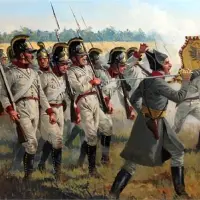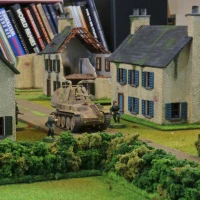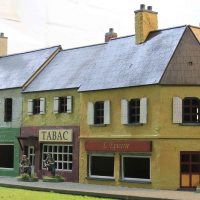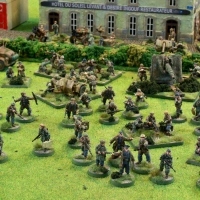
About four years ago I did the church from Commission Figurines and honestly thought I was good when it came to European churches.
But then Charlie Foxtrot released their eglise and I fell in love with that one, too. So after some thinking if I could justify buying another church (yes, as wargamers we all know there is always a justification… we just need to find one that sounds sensible 😉) I decided that the Commission Figurines one will eventually be modified for winter settings and that the Charlie Foxtrott one will be used for Normandy (and other parts of Western Europe set during the warm months).

As you can see it is an absolutely massive piece that will provide a great centrepiece for any French village. But with the roofs and the belltower coming off, it will be easy enough to store.

I went with a base coat of Vallejo IDF Sand Grey primer for the sandstone look and picked out about 80 – 90% of individual stones using the paints from the Life Colour stonewall set. One word of advise for anyone wanting to do it the same way… the kit is designed in a way that the large wings do not need to be permanently connected to the central tower. Leave them off during painting even if you want to have one coherent model in the end. I could have saved a couple of hours had I painted the church in smaller, more manageable pieces. And this would also have allowed me to use an airbrush instead of a regular brush, which would have saved another few hours.

Afterwards I hit the whole model with dust filters and washes to blend the colours in. I would usually do further weathering using oil paints, but felt that with the engraving in the MDF this might pick out the wrong spots, so I reserved those for the roofs and airbrushed on some Ammo Shaders in Starship Filth and Green colours to depict rainmakers, green decolouration for water damage and so on.

Unfortunately my printer is having some driver problems right now. So instead of printing out some stained glass onto clear foil, I simply painted broad stripes onto some clear foils using whiteboard markers and glued those into the windows. But the are only glued in quite loosely, so I can always replace them later if I want.

If you wonder… the church itself is perfectly flat… the two boards it is placed upon do create a slight bump under it.


The churchtower will provide a nice spot for snipers or spotters and inviting target for the enemy artillery.
I will probably do a few more things here. French churches are often in the centre of town / village, so I will most likely do a nice cobblestone base for it.
As a byproduct of the church being in the centre of town, the cemetery is usually seperate from the church at the edge of town. So I will have to do a seperate cemetery as well. In all honesty… I would have done that in one go with the church if I had found the cemetery walls I bought together with it. So I will probably have to buy them once more (and probably find the original ones a week later) or cut some from foam. Let’s see how that one goes! 😉
Oddly enough… I think Colin from Charlie Foxtrott was inspired by the church in Tilly-sur-Seulles when he designed the church (although that one has a small annex behind the altar and some doors are placed differently). And this is one of the few churches that have an attached cemetery.





































































